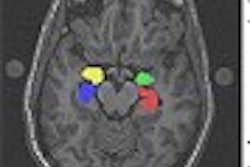SAN FRANCISCO - Accurate diagnostic information, efficient imaging, and "pretty pictures" should be the goals of any musculoskeletal imaging exam, and nailing down the basics of MR can go a long way toward achieving them, said a presenter Wednesday at the International Skeletal Society (ISS) meeting.
Dr. Mini Pathria reviewed some of the technical considerations of musculoskeletal MR, focusing on the key elements of a successful imaging protocol. Pathria is a professor in the department of radiology at the University of California, San Diego.
The imaging staff should first try to gather as much information as they can from the patient, including the name of the referring physician, insurance, and any possible contraindications. In Pathria’s department, digital photos of the patient’s areas of complaint are also obtained and added to the patient file.
"We use a DICOM scanner to scan in all the relevant paperwork for the patient. This is very useful. It’s also useful to incorporate some type of patient questionnaire that includes a pain diagram, and ask if the patient has had prior arthrography. Often the history that we obtain (from the referring physician) is rather skimpy," she said.
Next, Pathria recommended that a routine protocol be in place, regardless of the magnet configuration used in the MR system.
"Most of what you’ll be hearing about here today, of course, will be about the standard, high-field, whole-body system, but open-bore magnets and extremity magnets are making significant inroads," Pathria said. Closed-bore systems remain the gold standard for routine MR exams, because of their ability to image small body parts.
In turn, open magnets are well suited for patients who experience claustrophobia, and also allow for easier patient access. Extremity magnets are currently popular with orthopedic surgeons. Most standard MR imaging is done on 1.5-tesla systems, although 3-tesla units are growing in number and popularity, and even higher field-strength magnets are on the way, she said.
But Pathria warned that "patients, despite the beauty of the images that can be obtained at high field, prefer low-field open systems. As radiologists we really haven’t done very much to market high-field imaging. A lot of patients feel that the open systems are newer, and therefore they must be an improvement."
One way to make patients more comfortable in a standard MR system is for the radiologist to climb up "and experience the table and use the pads that are provided by the manufacturers," she suggested. "You’ll quickly discover that they are extremely uncomfortable. We like to replace those pads with (commercially available) comfortable, vinyl pads that provide good cushioning, because motion is really our enemy in MR."
Protocols
Adequate anatomic coverage is the most vital issue, Pathria said. Routine protocols should be established independent of the choice of imaging sequences. Pathria’s basic protocol consists of obtaining images with a large field of view (FOV) in the first sequence with fast inversion recovery, then switching to a smaller field of view for higher-resolution images (generally incorporating proton-density weighted fast spin echo). The sequences that are done last are the ones that are most uncomfortable for the patient, such as those that require an unnatural body position.
Spatial resolution
High spatial resolution is necessary when imaging small structures. It is achieved most efficiently with sequences that are fast and have a high signal-to-noise ratio (SNR). Pathria emphasized that spatial resolution is a function of the size of the voxel being imaged. The factors that determine voxel size are slice thickness, FOV, number of frequency encoding (FE) steps, and the number of phase encoding (PE) steps.
PE steps can play a part in creating and alleviating motion artifacts. Pathria reminded her audience that gross motion artifacts can completely distort and destroy images. But with minor, physiologic motion, the direction of the motion artifact seen is going to be in the PE direction.
Another artifact to watch out for in the PE direction is truncation artifact, most commonly seen in the cervical spine. Pathria said it can also be a significant problem when imaging the menisci, as this artifact can simulate a meniscal tear.
Signal-to-noise ratios
Because of the presence of fat in mesenchymal tissues, high SNR is relatively easy to obtain in musculoskeletal MR. Using fat-suppression techniques can significantly decrease SNR. Ways to improve the SNR include increasing the voxel size or increasing the number of excitations, although the latter does have drawbacks.
"Often what we will try to do is increase the number of excitations, but this is a very time-inefficient way of dealing with the problem," Pathria said. "Often the better way ... is to alter the pulse sequence that you are using, or to select a more appropriate coil for the area of interest."
Coils
"Coil selection is something that is critical for getting good, quality musculoskeletal MR images," Pathria said. "I’m sure most of you have a large variety of different coils that you can employ. I urge you to be creative and use them in unexpected ways. For example, a spine coil can provide beautiful images of the thigh or the upper arm."
Body coils should generally be reserved for studies that require a large FOV. Surface coils are convenient because they can be wrapped around the area of interest. They also provide a better SNR, although the FOV is often limited. The newest coils contain their own gradient coils, which augment the field strength of the main magnet. The increased SNR from these coils can be especially useful on low-field systems.
"One of the problems that we have with coil selection is the growing size of our patient population," Pathria said. "Patients that are very obese will often not fit into the whole-volume coils that are provided to us for extremity imaging."
Too much contact between the patient's skin and the coil can result in distortion, she added.
Contrast resolution
Pathria defined contrast resolution as the ability to discriminate between tissues with different signals. It is determined by tissue parameters, imaging parameters, and pulse sequences. The tissue parameters measured by routine MR are proton density, T1 relaxation time, and T2 relaxation time.
"When I think about contrast resolution, I think the most important (question) is ‘What kind of sequences are you employing?’ I like to think about sequences as belonging to one of two groups," Pathria said.
The first are sequences that emphasize altered morphology of the tissue. These include proton density weighting, T1 weighting, and gradient echo. The second are sequences that emphasize altered signal, such as STIR, T2 weighting, fast spin echo (FSE), and contrast enhancement.
"I try to think of these sequences as looking at the black stuff (tissue) or looking at the white stuff (water)," Pathria said. "I make sure that each of my protocols contains at least one (sequence) from both of those groups."
Finally, Pathria touched on imaging time and fat suppression. For speeding up the imaging time, gradient-echo (GE) sequences may be a better option than standard spin echo (SE). GE sequences are faster than SE because of a shorter TR, although they will offer less image contrast. In FSE imaging, multiple echo planes are collected during each 90° pulse. Echo-planar MR affords even more rapid imaging.
However, T2-weighted FSE does not offer fat suppression the way SE imaging does. "When we employ this particular sequence, we always employ it with fat suppression in order to enhance our visualization of fluid, both in the subcutaneous fat and within the marrow space," Pathria explained.
Pathria's own practice relies more on proton density-weighted FSE sequences for clearer pictures of anatomy and fluid.
By Shalmali PalAuntMinnie.com staff writer
September 18, 2003
Related Reading
MR Imaging of the Lumbar Spine: A Teaching Atlas, June 19, 2003
Symptomatic rotator cuff tears accompanied by contralateral asymptomatic tears, April 2, 2003
Gastric bypass battles bulge, but patients pose imaging challenge, March 27, 2003
Copyright © 2003 AuntMinnie.com



.fFmgij6Hin.png?auto=compress%2Cformat&fit=crop&h=100&q=70&w=100)




.fFmgij6Hin.png?auto=compress%2Cformat&fit=crop&h=167&q=70&w=250)











